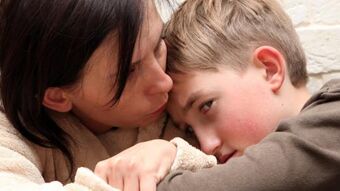Is poverty just about income?
Marriage and Family
In short, no, poverty is not just about income, but do read on! In much of today’s popular discourse, it is quite understandably assumed that the way to improve poverty rates is to improve the ‘take home’ (or post tax) incomes of those who are poorest, both in relative and absolute terms. Although under the previous administration poverty did fall between 1997-1998 and 2005-06, it began to rise again over the following three years[1] and, as a result, the much lauded child poverty targets were missed by some margin.[2]Taking this and the figures below into consideration, it is clear that any possible solution to reducing poverty in the UK will need to take into account a whole range of factors, just one of which income.
The figures above are compelling in that they show the UK to be comparatively generous with regard to the treatment of low earner households by the tax system.[3] These family types have a negative tax burden which means, in effect, that they receive more in benefits and tax credits than they pay in income tax and national insurance. This is primarily due to how the tax credit system (soon to be overhauled by the new Universal Credit) operates. It is interesting to note that households on the same proportionate income (50% of the average wage)[4] in some other developed countries do not enjoy such generous tax rates, although in many nations they are still below zero.
Herein lies the rub: despite the generosity of the UK tax credit system, child poverty has continued to rear its ugly head, both domestically over the past 10 years, and internationally (see graph below).[5] In other words, some other OECD nations, despite having tax and benefits systems which are relatively less generous, achieve significantly lower poverty rates. As the table below shows,[6] of the 20 countries with lower child poverty rates[7]than the UK, only three have more generous tax arrangements for one earner and lone parent two child households at this wage level. By way of explanation, the table below gives one rank for child poverty and one for tax burden. The higher the tax burden rank, the more negative the tax burden is for families on 50% average wage. With regard to child poverty, the higher the rank, the lower the poverty rate.
Why might this be the case? There are many reasons why poverty remains a significant issue for the UK, many of which need to be addressed: housing, education, tax and welfare to name but a few.
Let’s take a brief look at tax and welfare. The Joseph Rowntree Foundation (JRF), in their excellent and comprehensive publication, Monitoring Poverty and Social Exclusion 2011, note that being in poverty is not just about income and that household size matters too.[8] Thus, whilst the UK might be relatively generous with regard to tax and welfare, it is by no means the end of the story. The report confirms that increases in tax credits – particularly in 2008 and 2009 – have resulted in many families needing tax credits in order to avoid poverty.[9] Here we have a key problem: what happens when tax credits are withdrawn? The evidence available shows us that the high withdrawal rates of both tax credits and the Universal Credit will adversely affect work incentives for many people, not to mention the actual take home income for many households.
Don’t take it from me though, below is an excerpt from the aforementioned JRF report:
‘One factor influencing in-work poverty that is the direct responsibility of the DWP is the ‘taper’ on benefits. The combination of income tax, National Insurance and the benefit taper means that someone in work and getting tax credits faces an effective tax rate on any extra earnings of 73 per cent, way above the so-called ‘top’ rate of 50 per cent. With such a rate, extra work brings scant reward: someone in this situation on the minimum wage has to put in six hours overtime in order to make themselves £10 better off overall.Universal Credit is going to make this worse, putting the rate up to 76 per cent. Until 2010, the rate was ‘only’ 69 per cent.’[10]
So, how do we deal with this issue? I believe the solution lies in reducing the taper on the soon to be introduced Universal Credit. The Coalition will say that this is too expensive but I question this. If the Government can spare billions for other tax and welfare measures, such as increasing the personal income tax threshold (which is not a progressive measure that will help the poorest in society)[11]then why shouldn’t it commit to reducing the Universal Credit taper? By doing this, the Coalition would make significant inroads toward tackling the high withdrawal rates that are present with the current Universal Credit plans, meaning that those entering the workplace or increasing their hours are not threatened with losing their benefit. As a result, work can actually begin to be rewarding, lifting many households out of poverty.
[1] Joyce et al, Poverty and Inequality in UK: 2010, Institute for fiscal studies & Joseph Rowntree Foundation, May 2010, p.35 and figure 4.1a
[2] These targets being to half child poverty by 2010 and to end it by 2020, see http://www.jrf.org.uk/work/workarea/child-poverty
[3] Based on calculations made from Taxing Wages, 2011, OECD, p.109-142 (see more here: http://www.oecd.org/document/34/0,3746,en_2649_34533_44993442_1_1_1_1,00.html)
[4] Average wage is defined as the average full time male and female adult earnings, OECD, Taxing Wages 2010-11, May 2010, p.555.
[5] Joyce et al, Poverty and Inequality in UK: 2010, Institute for fiscal studies & Joseph Rowntree Foundation, May 2010
[6] Based on calculations made from Taxing Wages, 2011, OECD, p.109-142 (see more here: http://www.oecd.org/document/34/0,3746,en_2649_34533_44993442_1_1_1_1,00.html)
[7] Defined in this instance as ‘the child poverty rate (the share of all children living in households with an equivalised disposable income of less than 50% of the median for the total population), the poverty rate of households with children (the share of the population in households with children with an equivalised income of less than 50% of the median) and the poverty rate for the total population (the share of all individuals with an equivalised income of less than 50% of the median).Child poverty, Oct 2011, OECD (available here:http://www.oecd.org/dataoecd/52/43/41929552.pdf)
[8] Aldridge et al, Monitoring Poverty and Social Exclusion, Joseph Rowntree Foundation, 2011, p. 8 (An electronic version of the report can downloaded from http://www.jrf.org.uk/sites/files/jrf/poverty-social-exclusion-assessment-full.pdf)
[9] Aldridge et al, Monitoring Poverty and Social Exclusion, Joseph Rowntree Foundation, 2011, p. 6
[10] Aldridge et al, Monitoring Poverty and Social Exclusion, Joseph Rowntree Foundation, 2011, p. 11




Share story
Is poverty just about income?